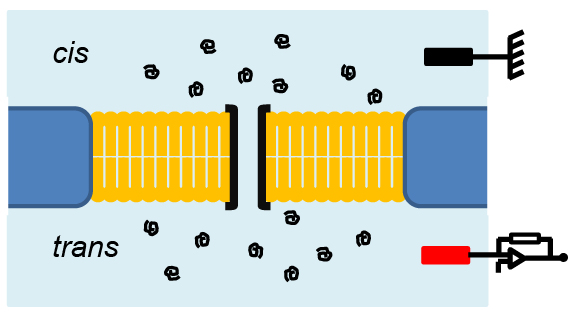EPJ E Highlight - Remote control of transport through nanopores
- Details
- Published on 14 May 2018

New study outlines key factors affecting the transfer of molecules through biological channels
In our bodies, the transfer of genetic information, viral infections and protein trafficking, as well as the synthesis and the degradation of biomolecules, are all phenomena that require the transport of molecules through channels. Improving our control of these channels and the capacity of molecules to get across could have many potential applications in the fields of energy, biotechnology and medicine. These include ultra-fast DNA sequencing, detection of biological markers used in disease diagnostics, protein folding, high-resolution determination of the size of biological molecules or even the control of ion or biomolecule transport through the protein sensor. In a new study published in EPJ E, Manuela Pastoriza-Gallego from the University Paris-Seine, France, and colleagues have shown how to alter external factors, such as external voltage, to control the transport of a dextran sulfate molecule - a polyelectrolyte - through the nanopores of the aerolysin protein channel.
Molecules crossing such biological channels are often made up of a chain of atoms, which may be larger than the pore diameter, typically smaller than 2 nanometers in width and 10 nanometers in length. This means a driving force is necessary to overcome the energy barrier of the channel confining the chain to the nanopore. The level of this energy barrier also depends also on the molecule-pore interactions. The authors previously studied a different nanopore, called alpha-hemolysin.
To study the dynamics in confined medium at the single molecule level, scientists rely on electrical detection. They have identified the impact of partially folded protein chains when crossing the channel, which lead to very long blockades in nanopores. Based on a comparison with their previous work on alpha-hemolysin nanopores, they have proven that protein unfolding transition is independent of the nanopore used. For completely unfolded protein, the authors have demonstrated that the entry into the pore needs to overcome a minimum energy barrier. They have also shown that the transport time decreases exponentially with the applied voltage and increases with the protein chain length.
Dynamics of polyelectrolyte through aerolysin channel as a function of applied voltage and concentration. M. Pastoriza-Gallego, B.Thiébot, L. Bacri, L. Auvray, J. Pelta (2018), Eur. Phys. J. E 41: 58, DOI 10.1140/epje/i2018-11661-4





